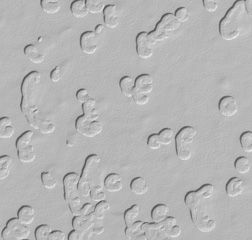geotimesheader
Highlights
Planetary
Geology
James W.
Head III
Exciting results continue to pour in about Mars,
asteroids and the Galilean satellites of Jupiter, but failures of the Mars
Climate Orbiter and the Mars Polar Lander in 1999 caused reexamination
of Mars exploration. On the positive side, planetary exploration produced
some fundamental results this year. These new results could be shared virtually
immediately through the increasing sophistication and accessibility of
the Internet.
A new moon emerges
The Lunar Prospector spacecraft was de-orbited
and made to crash into the south polar region of the moon to test for the
presence of polar ice (none was found). Prospector and earlier datasets
allow complete analysis of the Moon’s gravity, topography, mineralogy,
chemistry and other crustal and interior properties. These data suggest
new ideas about the Moon’s evolution. The European Space Agency has begun
the SMART-1 mission (http://sci.esa.int/smart)
to be launched in 2002 to follow up on some of these ideas and develop
new technology, and Japan will send Lunar-A to the Moon in 2002 to deploy
penetrators with heat flow and seismic instruments on the nearside and
farside (www.isas.ac.jp/e/enterp/missions/index.html).
Mercury on the horizon
The least known of the terrestrial planets, Mercury,
will finally be explored by NASA’s Discovery Mission (Messenger;
http://sd-www.jhuapl.edu/sdhome/Discovery/messenger/).
Missions during 2008-2009 will investigate unusual polar deposits of possible
water ice, planetary surface features, a very large core, a magnetic field
and enigmatic crustal mineralogy and geochemistry.
| Water on Mars
The Mars Global Surveyor
Mission continues to produce spectacular results (http://mars.jpl.nasa.gov/mgs/index.html).
Mars Orbiter Laser Altimeter data are providing evidence for large drainage
basins, ancient polar deposits, ocean-scale bodies of water in the past
history of Mars, extensive volcanism and unusual crater characteristics.
The Mars Orbiter Camera put Mars under a microscope at several-meter-scale
resolution.
The thermal emission spectrometer recorded regional
deposits of hematite and two types of igneous rock (basalts and basaltic
andesites) apparently typical of the southern uplands and northern lowlands,
respectively. Gravity and topography data suggest that heat loss in earlier
Mars history may have been greater in the northern lowlands. The details
of future Mars exploration missions are uncertain, but the goal is return
of samples. The European Space Agency will send the Mars Express mission
in 2003 with an imaging spectrometer, very high resolution stereo cameras
and ground-penetrating radar (http://sci.esa.int/marsexpress/). |

Portion of the south polar residual cap of Mars. The upper surface
is dotted with a combination of polygonal patterns created by shallow
troughs and large, almost circular pits formed by collapse. It appears
the large arcuate and circular pits formed from collapse, which means
that something underneath them has been removed. Alternatively, the
ice that makes up much of the polar material has somehow become
compacted, allowing the surface to sag and create pits. This Mars Global
Surveyor Mars Orbiter Camera view of the south polar cap surface was
obtained Nov. 3, 1999. This view covers 3-by-3 kilometers at 1.5 meters
at 1.5 meters per pixel. The pits are only a few meters deep, at most,
as
determined by measuring shadows cast in them.
NASA/JPL/Malin Space Science Systems. |
The building blocks of
planets
Exploration of comets and asteroids is revealing
the nature of the basic building blocks of the solar system. The Near Earth
Asteroid Rendezvous spacecraft (recently renamed in honor of Eugene Shoemaker,
the pioneering planetary geologist) went into orbit around the asteroid
Eros (http://near.jhuapl.edu/). Stardust
is on its quest to return comet debris to Earth (www.jpl.nasa.gov/stardust/top.html).
A Japanese mission, MUSES-C, will be launched in 2002 to return samples
from an asteroid (www.isas.ac.jp/e/enterp/missions/index.html).
Volcanoes and oceans
The Galileo spacecraft returned new images of
active eruptions on Io, catching a “curtain of fire” in the act. New results
from the icy satellites suggest that there may be liquid water layers (“oceans”)
beneath the surface of Europa, Ganymede and Callisto. More new data on
Europa support a very young age and a relatively thin (a few kilometers)
icy crust (www.jpl.nasa.gov/galileo/;
www.jpl.nasa.gov/galileo/europa/).
And if that’s not enough
...
Cassini is well on its way to Saturn (passing
Jupiter soon) to study Saturn's atmosphere, rings, magnetosphere, and icy
satellites (www.jpl.nasa.gov/cassini/).
In 2004, the Cassini Huygens probe will descend to Titan's surface to assess
processes that might have led to the development of life. Missions are
being planned to orbit and land on Europa and to visit Pluto in the next
decade or so. Most newly reported systems of planets around other
stars look little like our solar system. New knowledge of our own and other
planetary systems will enable us to better understand the formative years
and context of Earth.
Head teaches planetary geosciences
at Brown University and is an investigator on the Mars Global Surveyor,
Galileo Europa, Messenger and Mars Express missions. E-mail: James_Head_III@brown.edu

